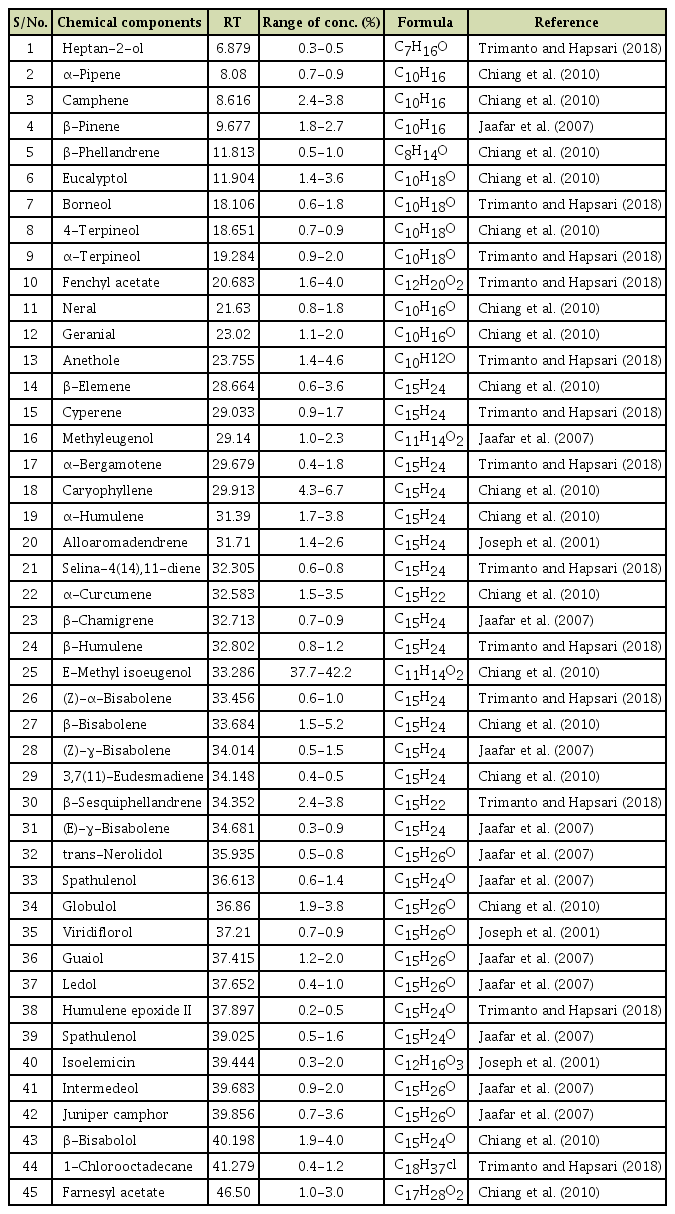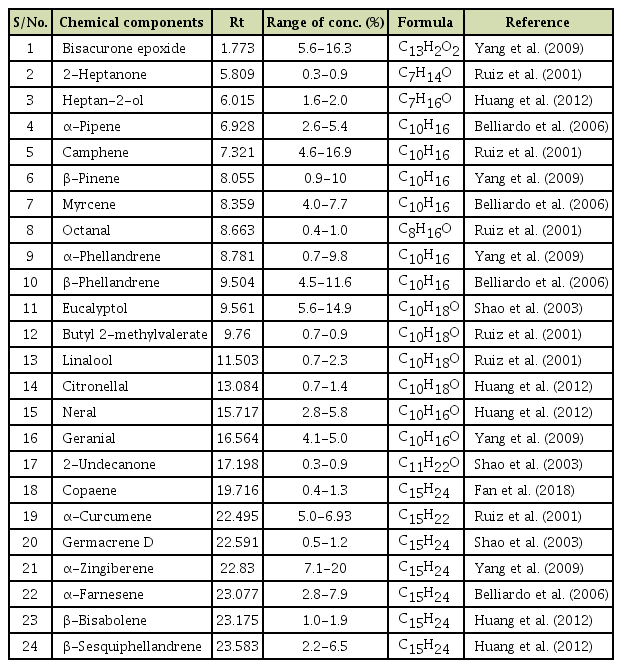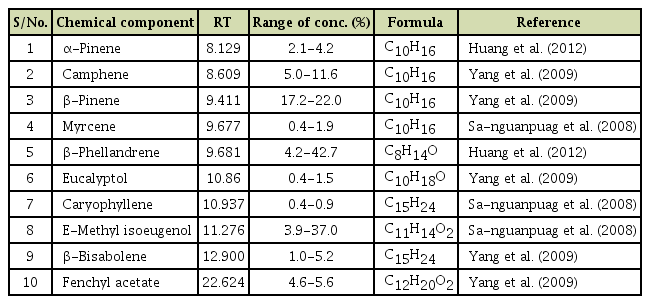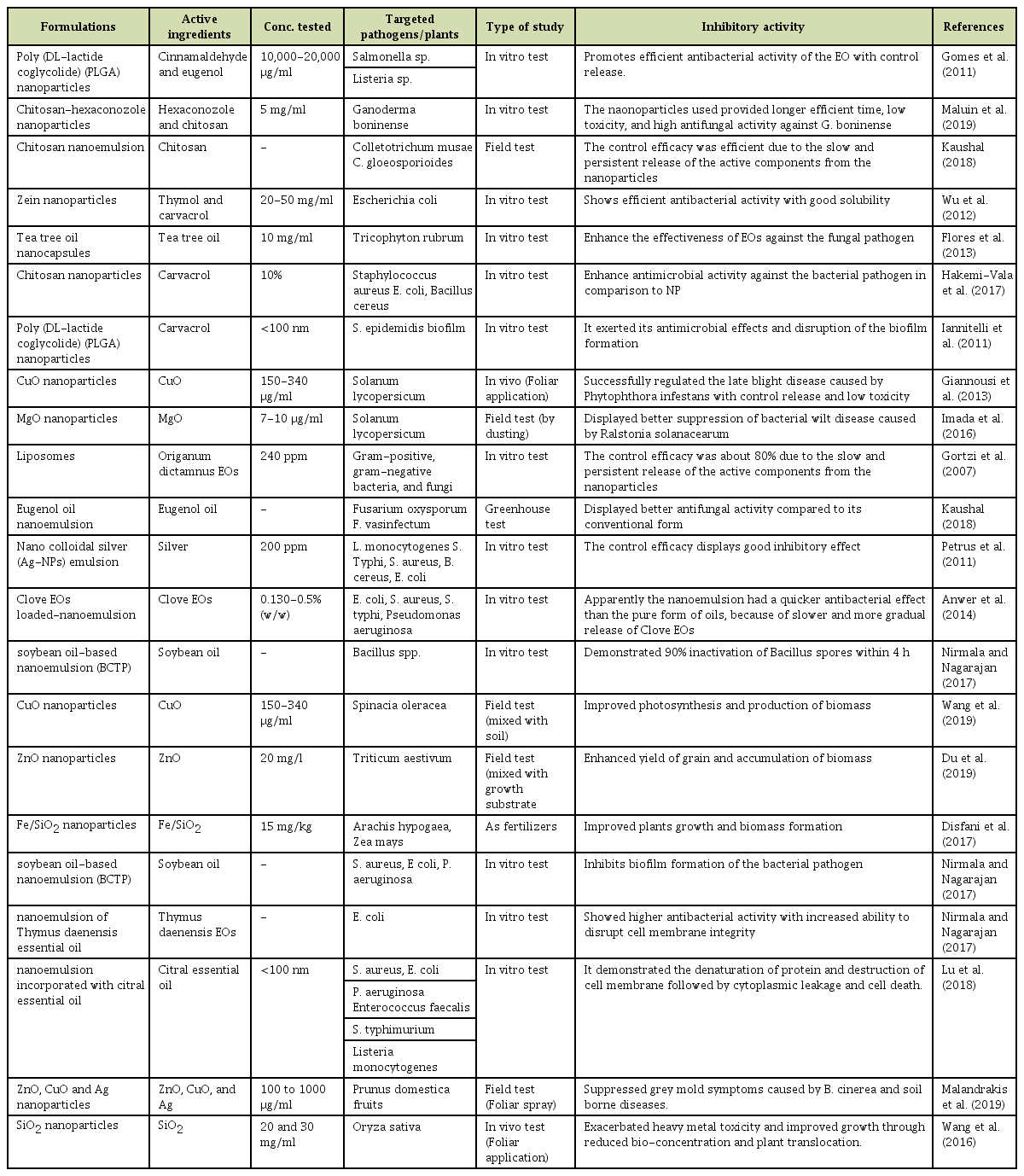Potential of Using Ginger Essential Oils-Based Nanotechnology to Control Tropical Plant Diseases
Article information
Abstract
Essential oils (EOs) have gained a renewed interest in many disciplines such as plant disease control and medicine. This review discusses the components of ginger EOs, their mode of action, and their potential nanotechnology applications in controlling tropical plant diseases. Gas chromatography-mass spectroscopy (GC-MS), high-performance liquid chromatography, and headspace procedures are commonly used to detect and profile their chemical compositions EOs in ginger. The ginger EOs are composed of monoterpenes (transcaryophyllene, camphene, geranial, eucalyptol, and neral) and sesquiterpene hydrocarbons (α-zingiberene, ar-curcumene, β-bisabolene, and β-sesquiphellandrene). GC-MS analysis of the EOs revealed many compounds but few compounds were revealed using the headspace approach. The EOs have a wide range of activities against many phytopathogens. EOs mode of action affects both the pathogen cell’s external envelope and internal structures. The problems associated with solubility and stability of EOs had prompted the use nanotechnology such as nanoemulsions. The use of nanoemulsion to increase efficiency and supply of EOs to control plant diseases control was discussed in this present paper. The findings of this review paper may accelerate the effective use of ginger EOs in controlling tropical plant diseases.
In spite of the technological advances in modern agriculture, it remains difficult to control plant diseases in tropical regions because of the limited capacity of chemical products (bactericides, fungicides, among others) to controls diseases without some negative effects (Ghormade et al., 2011; Nega, 2014). In the tropics, the accessibility of effective yet harmful chemicals for controlling plant diseases is scarce (Bajpai et al., 2011; Panth et al., 2020). Moreover, antibiotics and copper based products which are used in plant disease control have adverse effects on human, animal, and environmental health (Hajano et al., 2012; Sundin et al., 2016). The use of antibiotics in controlling plant diseases in many countries have been banned (Buttimer et al., 2017; Pal and Gardener, 2006). Plant disease control often needs expensive and complex integrated pest control approaches to some degree, including environmental management options, the use of unrestricted-pathways and disinfecting approaches (Dara, 2019). Therefore, these limitations affects the control effectively of plant diseases in agriculture (Mcmanus et al., 2002).
Sustainable food production is the key to ensuring food security. Implementation of creative disease management program to reduce the incidence of plant diseases and pathogen resistance is one of the important strategies worth pursuing to achieve this goal. Planning and implementing successful strategies for disease management is necessary to guarantee sustainable crop production systems (Saha et al., 2016). Tropical plants disease outbreak had threatened the ecosystems and agricultural crops which had forced research community to find innovative ways in inhibiting pathogen growth while maintaining crop yield, quality and health status. The use of natural plant products such as ginger essential oils (EOs) is an ideal approach for plant protection in the tropics. In recent times, plant natural products are used not only because of their biological and antimicrobial activities to counter plant diseases (Abdel-Kader et al., 2015) but also for their economic viability and low toxicity (Brusotti et al., 2014). Moreover, plants are well known for their antibacterial, antiviral, antifungal properties, and insect repelling properties (Kumari et al., 2014; Nour et al., 2017; Sendanayake et al., 2017). Possible applications of ginger EOs and their components to control plant diseases in the tropics are being intensified because they are showing promising results both in laboratory and field conditions (Lanzotti et al., 2013; Popović et al., 2016).
Ginger EOs have phytoconstituents such as monoterpene and sesquiterpene hydrocarbons (Dhanik et al., 2017). Analytical methods such as gas chromatography-mass spectroscopy (GC-MS) and headspace chromatography can be used to identify bioactive compounds in ginger EOs (Koch et al., 2017; Marriott et al., 2001). This approach will enable identification and outlining EOs components to assist in achieving the objectives of identifying those compounds responsible for antimicrobial efficacy (Bhattarai et al., 2018; López et al., 2017). The EOs have demonstrated excellent antimicrobial activity against pathogenic microorganisms (Debbarma et al., 2013; Mostafa, 2018; Nikolic et al., 2014; Wonni et al., 2016). However, because of their low water solubility and high sensitivity to oxygen, moisture, heat, and light, so that the use of EOs is limited. The emergence of advanced technologies is making it possible to fix the aforementioned problems associated with EOs use in tropical disease management. The ginger EOs nano-based delivery systems such as nanoemulsions is one of the models for enclosure of these natural bioactive compounds to enhance antimicrobial activity, thus, it can bring active compounds to the desired site, shield them from adverse environmental factors to increase their effectiveness (Donsi and Ferrari, 2016). The mechanisms of action of ginger EOs/ginger EOs nano-based product can affect cells’ external package and internal structures. The most likely result of the antimicrobial action is a blend of activities with different targets within a cell. The hydrophobic nature of EOs/EOs nano-based product might be responsible for the destruction of a cell structure resulting in increased permeability because of the cell inability to distinguish the EOs from the cell membrane components (Nazzaro et al., 2013).
Consequently, in order to deal with old and new emerging plant diseases and other threats to crop production, farmers and researchers need to be well versed in the use of natural products such as nanotechnology-based ginger EOs. Efficient and viable plant protection measures using nanotechnology-based ginger EOs are important for society’s economic, environmental and social well-being. Increased in crop yields can be related to good plant disease management, including a deeper understanding of natural compounds (ginger EOs) and their use as an efficient way to combat tropical plant diseases. This paper discusses the importance of ginger EOs, EOs-nanotechnology and phytochemical components as antimicrobial active agents as well as their potential applications in controlling plant diseases in the tropical regions. The mechanisms of action of ginger EOs are also discussed.
EOs and Phytochemistry
Ginger’s distinctive constituents are fragrant and pungent types. The fragrant part is commonly referred to as EOs. EOs are semi-oily yellowish volatile aromatic liquids that are derived from plant materials such as leaves, flowers, fruits, stems, roots, and seeds through steam/hydro distillation (Böhme et al., 2014). They are biosynthesized from plants and plants’ secondary metabolites (Fitriady et al., 2017), which are usually found in unique cells or organized cells (Nirmala and Nagarajan, 2017). EOs have multiple functions in plants of which they are found to be a part of the plant’s defense mechanisms. In ginger EOs, many chemical compounds were identified and analyzed for their chemical structure using analytical approaches such as high-performance liquid chromatography, GC-MS (Nour et al., 2017), and headspace (Bylaite et al., 2000). However, there are literature that reported EOs components can be analyzed using gas chromatography but quantifying is done or can be done using spectrophotometer or a combination of these techniques (Ali et al., 2008; Koch et al., 2017). These techniques are commonly used to determine the volatile compounds in ginger EOs. The mass spectrum of the obscured constituents of ginger are commonly identified by comparing their retention times (RT), similarity index, and mass spectral data (Chiang et al., 2010; Trimanto and Hapsari, 2018; Vairappan et al., 2012). In general, RT is useful information for characterizing and distinguishing EOs components (Bhattarai et al., 2018), but they are poorly reproducible over the long term or between different systems and should be relied on only when calculating comparison and sample under the same conditions and shortly after one another. In particular, all factors that could impact RT under otherwise constant conditions could also theoretically affect retention indices. All processes that disrupt or reduce or change the column selectivity of the gas chromatographic separation can cause significant deviations in retention indices (Koo et al., 2014).
The active chemical components in ginger EOs are divided into two major groups, namely, monoterpenes and sesquiterpene hydrocarbons with the general formula of (C5H8)n and oxygenated hydrocarbon compounds, including aldehydes, phenols, esters, oxide ethers, alcohols, and ketones. Approximately 1,000 monoterpene and 3,000 sesquiterpene hydrocarbons exist. There are other pungent constituents in ginger EOs but in small quantities. Gingerol, shogaol, and paradol, are specific compounds containing sulphur or nitrogen. The chemical components of EOs are similar to those for oils, but differ in their texture, not greasy, and light in weight (El Asbahani et al., 2015). The most abundant chemical compounds in ginger EOs are α-zingiberene, geranial, α-curcumene, β-bisabolene, β-sesquiphellandrene, and neral. These compounds have been related to which most biological activities and distinctive flavor/aroma of EOs. Table 1 shows the presence of monoterpene components such as trans-caryophyllene, camphene, geranial, eucalyptol, and neral as well as sesquiterpene hydrocarbons mainly α-zingiberene, ar-curcumene, β-bisabolene, β-sesquiphellandrene. The most reported available components with high concentrations (%) are α-zingiberene (18.0-28.0%), geranial (7.8-13.8%), neral (5.3-10.5%), trans-caryophyllene (9.0-10.8%), eucalyptol (5.0-5.5%), β-phellandrene (4.9-5.5%), camphene (5-11.5.0%), α-pinene (2.1-3.0%), and heptan-2-ol (1.0-2.0%). These compounds might be responsible for their distinctive flavor and aroma as well as antibacterial and antifungal activities. Table 2 shows the chemical compounds in wild ginger EOs. Monoterpenes such as camphene, geranial, geranyl acetate, anethole, fenchyl acetate, and neral as well as sesquiterpene hydrocarbons mainly α-humulene, α-curcumene, β-bisabolene, and β-sesquiphellandrene were identified. The most abundant compounds are E-methyl isoeugenol (37.7-42.2%), caryophyllene (4.3-6.7%), β-bisabolene (1.5-5.2%), anethole (1.4-4.60%), eucalyptol (1.4-3.6%), β-bisabolol (1.9-4.0%), globulol (1.9-3.8%), arcurcumene (4.4-11.5%), α-humulene (1.7-3.8%), fenchyl acetate (1.6-4.0%), β-pinene (1.8-2.7%), alloaromadendrene (1.4-2.6%), and geranial (7.8-13.8%) responsible for the distinctive flavor and aroma.
The constituents of ginger EOs are strongly associated with place of origin or geographical location, and also whether the rhizomes are fresh or dried (Koch et al., 2017). Fresh ginger EOs are of higher quality in terms of fragrance/flavor than dried ginger, thus receiving more oils and better anti-microbes activity (Mahboubi, 2019; Onyenekwe and Hashimoto, 1999). Similarly, Tables 3 and 4 shows the chemical compounds in domestic and wild ginger by headspace method, they are characterized by monoterpenes such as camphene, geranial, linalool, and neral. The most abundant compounds are sesquiterpene hydrocarbons, mostly α-zingiberene, ar-curcumene, β-bisabolene, β-sesquiphellandrene, β-ionone 5,6-epoxide and their % concentrations are camphene (4.6-16.9%), β-ionone 5, 6-epoxide (5.6-16.3%), eucalyptol (5.6-14.9%), β-phellandrene (4.5-11.6%), α-zingiberene (7.1-20%), α-pinene (2.6-5.4%), geranial (4.1-5.0%), myrcene (4.0-7.7%), neral (2.8-5.8%), α-farnesene (2.8-7.9%), heptan-2-ol (1.6-2.0%), β-sesquiphellandrene (6.5-11%), and β-bisabolene (1.5-5.2%). These compounds could be associated with the distinctive flavor and aroma of EOs as well as their antibacterial and antifungal activities whereas the wild ginger type is made up of β-phellandrene (4.2-42.7%), β-pinene (17.2-22.0%), α-pinene (2.1-4.2%), and E-methyl isoeugenol (3.9-37.0%) as the major constituents (Awang et al., 2011; Bhattarai et al., 2018; López et al., 2017; Mahboubi, 2019; Şener et al., 2017). However, different analysis of natural products yields different efficiencies (Sharifi-Rad et al., 2017b) because of factors such as time for analysis and rhizomes are not efficiently utilized by headspace. In other words, some of the phytoconstituents are hidden in the rhizomes compared to the extracted EOs. Fig. 1 shows selected chemical structures of components in ginger EOs (Mahboubi, 2019). Furthermore, Table 5 shows that ginger possess chemical classes and biological activities such as antibacterial, antifungal, antioxidant, and anti-inflammatory activities (Mahboubi, 2019; Mao et al., 2019) because many monoterpene components and sesquiterpene hydrocarbons are known to be the main components of EOs.
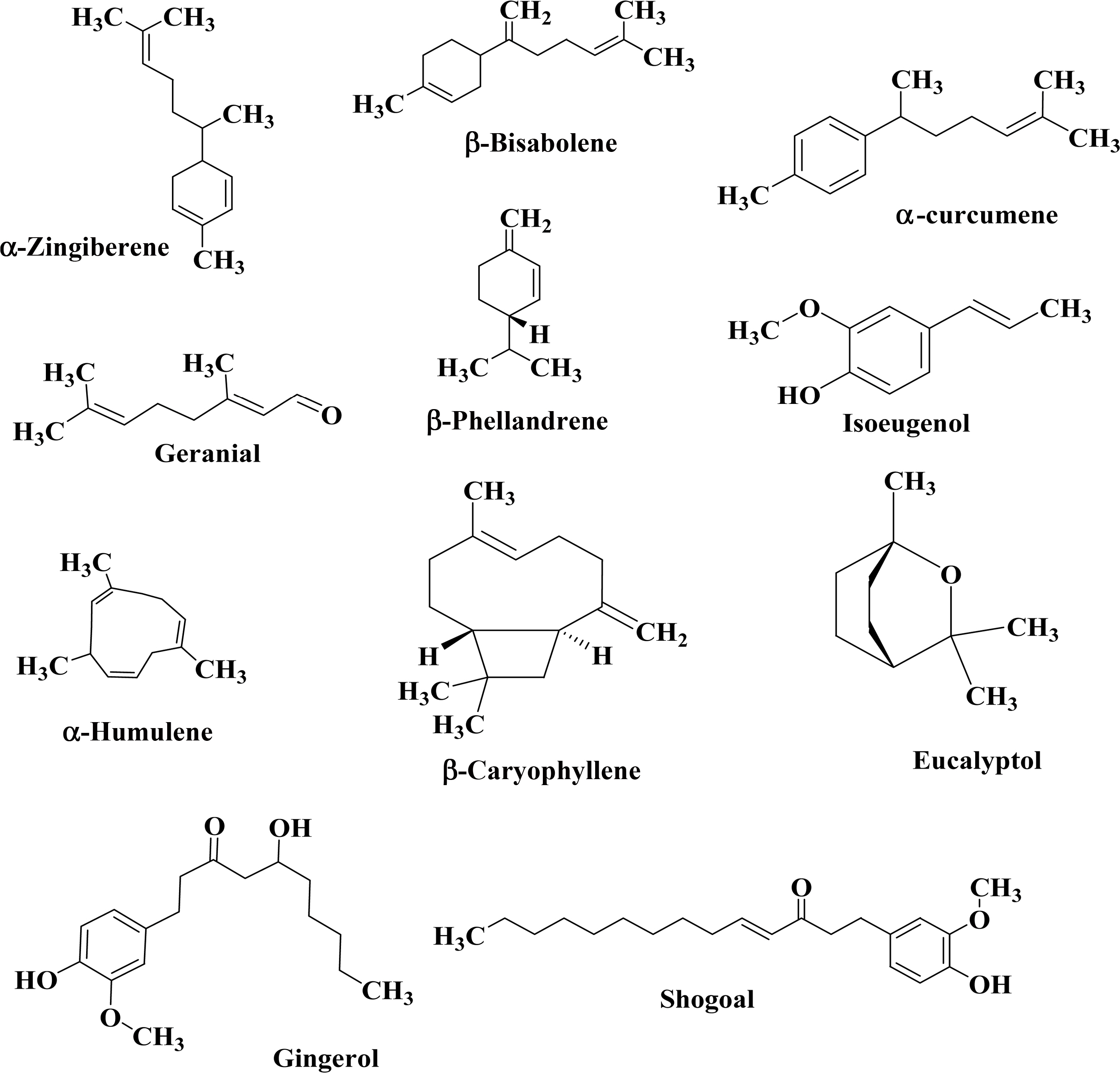
Some selected chemical structures of components in wild and domestic ginger essential oils. Major bioactive molecules of essential oils (EOs) and their pharmacological activities play an important role in the protection of crops in the tropics, such as antioxidant, antifungal and antibacterial activities. With the associated mechanisms of action, the effect of EOs and the functions of their major components in the tropics as natural preservatives cannot be overemphasized.
Antimicrobial Activity of Ginger EOs
The escalating economic and social effects of plant pathogens inevitably suggest that continuous steps are being taken to monitor plant diseases in order to produce nutritious and pesticides-free foods. This can be achieved by developing and adopting natural antimicrobials from plant sources like ginger EOs and these important issues has generated interest amongst scientific community (Li et al., 2020). Generally, ginger EOs is non-phytotoxic substances and are possibly efficient against many plant pathogenic microbes. The use of antimicrobial compounds from plant sources such as EOs has been one of the first options following outbreaks of plant diseases in recent years.
The antimicrobial properties ginger EOs had been extensively studied using advanced scientific methods. The evaluation of the antimicrobial activity of EOs is done by testing their effectiveness on living organisms such as bacteria and fungi, which can range from molecular tissue to the whole organism. It is a stage of evaluating the conduct of the EOs on the test species (Gurjar et al., 2012). The potential application of EOs against both bacteria and fungi have been reported mostly in vitro tests. The findings had suggested substantial antimicrobial activities compared with the standard control against many plant pathogens (Al-Hetar et al., 2011; Alzoreky and Nakahara, 2003; Sharma et al., 2016). Such findings suggested that many bacterial and fungal pathogens could be managed effectively by ginger EOs.
Furthermore, earlier in vitro and in vivo studies had indicated that ginger EOs could be used as effective antimicrobial agents for animal diseases. However, data on the antimicrobial activity of ginger EOs against plant bacterial and fungal pathogens are very minimal. Nevertheless, because of the biologically active compounds present in ginger EOs are known to be antibacterial and antifungal bioagents, thus the research interest on testing for controlling plant diseases are increasing. Many studies revealed that the characteristics of the oils contributing to the respective antimicrobial activity depend on the nature of the plant volatile oils, the structural arrangement of the components, and their functional groups or potential synergistic interactions between the components. The correlation between the antimicrobial activity of the compounds and their relative percentage composition in the plant volatile oils with their chemical structure, functional groups, and configuration, indicates their bioactivity (Dorman and Deans, 2000).
In field experiments, the antimicrobial properties of ginger EOs with non-toxic features can be used to evaluate disease control efficacy on tropical plant diseases such as fusarium wilt of banana (Fusarium oxysporum f. sp. cubense), papaya dieback (Erwinia mallotivora), and basal stem rot of oil palm (Ganoderma boninense). The effects of EOs on tropical field crops are distinct from those of the conventional pesticides. Nonetheless, in comparison to the EOs, the test outputs of chemical pesticides may demonstrate in higher degree of effectiveness. However, other report revealed that EOs play a key role on various crops production as assessed by the integrated pest management program (IPM), in which specific approaches work in a synergistic manner for high yield and quality product (Bhavaniramya et al., 2019). Therefore, intensive open field experiments are needed to uncover the mechanisms underlying the antimicrobial activity of ginger EOs with their interactions as well as improving their action against the target host through nanoemulsion approach could protect crops against pathogenic microbes.
Possible Mechanisms of Ginger EOs
It is believed that EOs antimicrobial activity against multiple cell targets of plant pathogens (Wu et al., 2019). Many researchers had used high resolution microscopes such as scanning electron microscopy and transmission electron microscopy to observe morphological changes inpathogen cells when in contact with EOs (Inkson, 2016; Wu et al., 2019). The micrographs usually show the cell surface of pathogen cells as not smooth and irregular (Wu et al., 2019) in suggesting that EOs could deteriorate the cell membrane morphology, dysfunction of mitochondria, and proteins synthesis resulting in multiple clefts, ending in disruption, and lysis of a cell (Sahu et al., 2018). Fig. 2 demonstrates that inhibition of growth and development of phytopathogens by ginger EOs.
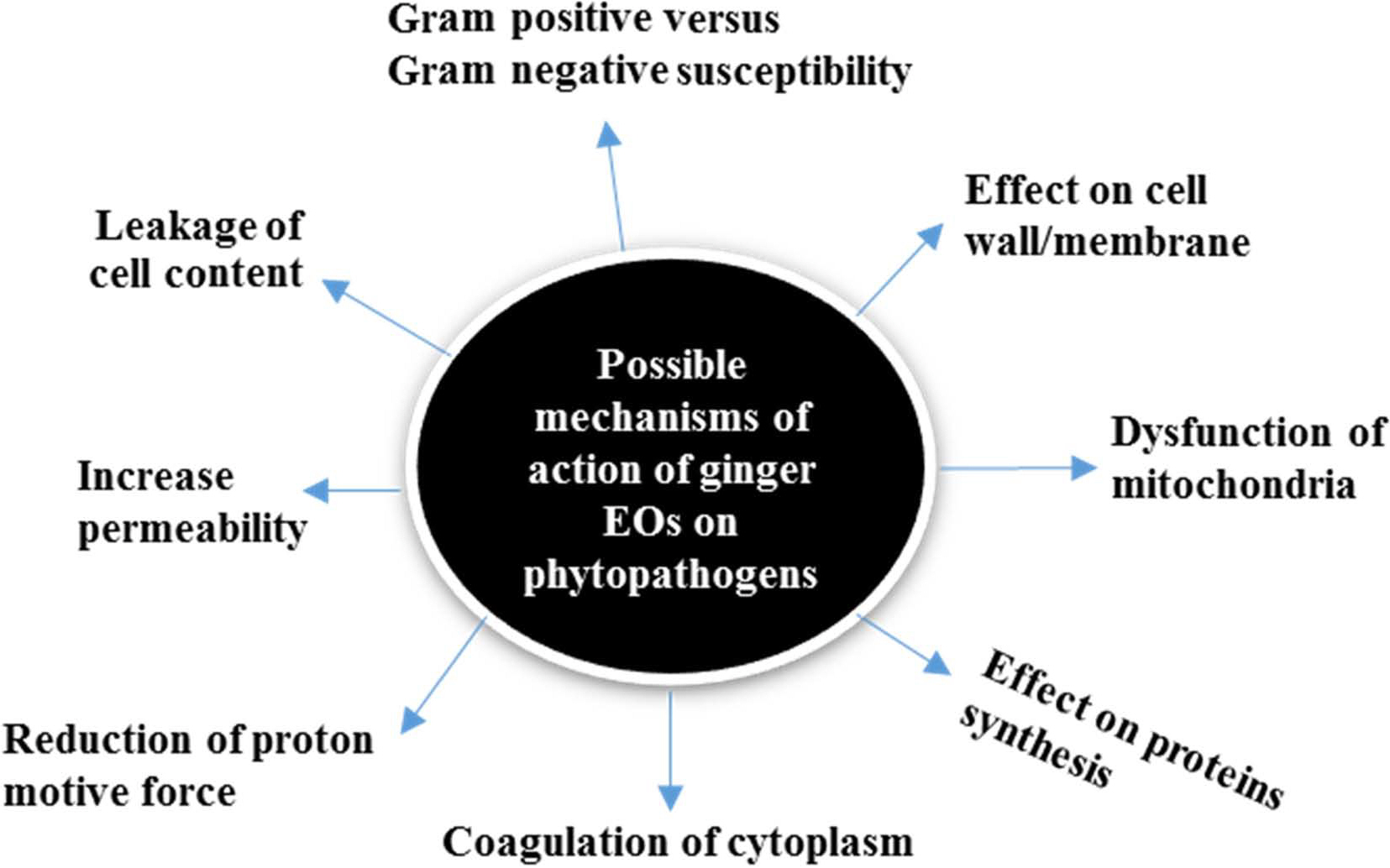
Roles of ginger essential oils on phytopathogen cells for plant disease control. The essential oils (EOs)’ biological properties are closely related to their aromatic compounds. In relation to mechanisms of action, the chemical composition of the EOs and their in vitro phytotoxic activity against phytopathogenic cells play an important role in crop protection in the tropics.
Gram-positive and Gram-negative susceptibility.
A wide range of in vitro antimicrobial assessment have been used for EOs assays (Arifullah et al., 2014; González Villa and Veiga-Crespo, 2014; Liu et al., 2017; Vasireddy et al., 2018). In terms of susceptibility, Gram-positive bacteria more susceptible to EOs compared with gram-negative bacteria (Dhifi et al., 2016) because is the fact that Gram-negative bacteria are the holders of the outer membrane covering the cell wall of plant pathogenic bacteria. Therefore, offer greater resistance to EOs by preventing easy diffusion through the lipopolysaccharide membrane and preventing their accumulation in the cell (Tao et al., 2019). In addition, the cell of the Gram-negative bacteria is rigid, rich in lipopolysaccharide, and more complex, thus restricting the diffusion of hydrophobic compounds through cell membrane, whereas this extra-complex membrane is absent in Gram-positive bacteria which are only surrounded by a thick peptidoglycan wall, lipophilic ends of lipoteichoic acid in the cell membrane, which is really not sufficiently dense to stop smaller antimicrobial molecules, thus, enabling entry to the cell membrane (López et al., 2017; Nazzaro et al., 2013). A number of reports revealed that the EOs effects are as a result of additive, versatile or antagonistic characteristics of individual components in different amounts (Dhifi et al., 2016; Vasireddy et al., 2018).
Effects of EOs on cell wall/membrane.
Hydrophobicity is the most important characteristic that makes the operation of EOs in living cell effective. EOs can partition into the lipids layer of cell membranes as hydrophobic compounds (Sahu et al., 2018). Such action disturbs cell membrane and makes it more permeable, enabling ion and metabolite leakage (Chouhan et al., 2017). Whereas leakage does not result in a loss of cell viability up to a certain point, further leakage may be lethal (for example, bacterial cell membrane) (Tao et al., 2019). In a related study, a decrease in pH was reported because of the disruption of the cell membrane of plant pathogenic bacteria (Chouhan et al., 2017) suggesting that regulation of cellular processes such as transcription of DNA, protein synthesis, or activation of enzymes were altered (López et al., 2017). The significant feature of EOs and their constituents is their hydrophobicity. This enables them to partition cell walls and part of cells in lipids, disrupting structures, and making them more permeable (Fig. 3). EOs tend to function on cytoplasmic membrane as cell proteins (Dhifi et al., 2016; Lucas et al., 2012). Such action disturbs cellular processes resulting in alteration of protein synthesis. There are two major pathways of the mechanisms of action. The EOs lipophilic molecules that accumulate in the lipid bilayer of the cell interact with lipid-protein to alter the phospholipid bilayer integrity or by interacting with the embedded phospholipid bilayer active transport proteins (Chouhan et al., 2017).
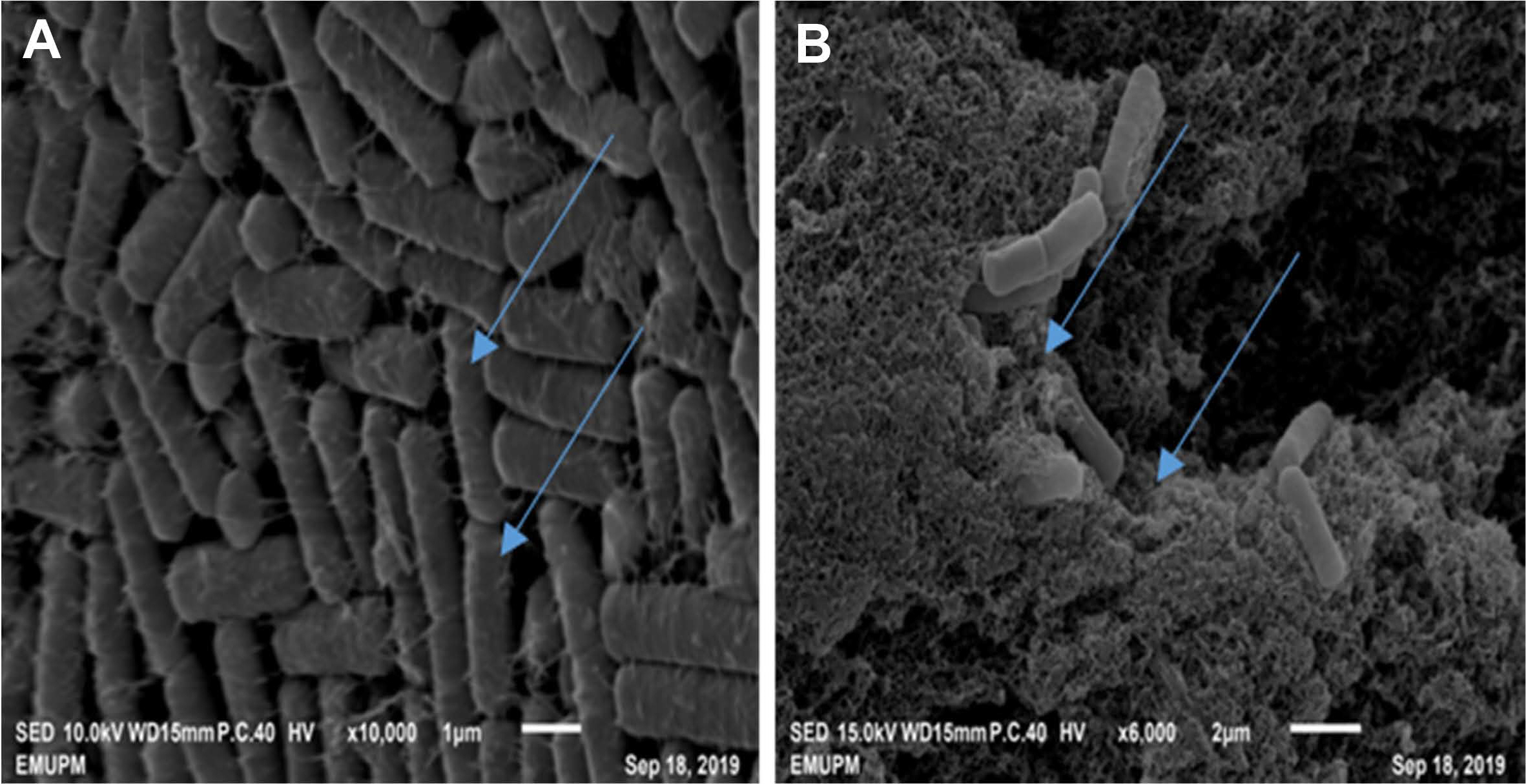
Transmission electron micrograph showing the effect of ginger essential oils (EOs) on bacterial cells which causes ultrastructural modifications. (A) Cells with a normal rod shape, smooth and bright surface. (B) Cells treated with ginger EOs showing irregular shape with sunken surfaces, severely disruption of the cells, thus, lead to membrane disruption, protein, and mitochondria dysfunctions, DNA damage which lead to inhibition of electron transport chain and metabolic process regulation, and finally cell death.
Dysfunction of mitochondria.
The principal mechanisms which mediate the cytotoxic effects of EOs are activation of cell death by inducing apoptosis and/or necrosis processes, cell cycle suspension, and the loss of essential organelles (Sharifi-Rad et al., 2017a). Several effects occur because of the lipophilic nature and low molecular weight of the main components made up of EOs which enable them to cross cell membranes, alter membrane composition and changing membranes resulting in lower production of ATP, changes in pH gradient, and depletion of mitochondrial ability leading to cell death (Dhifi et al., 2016). EOs can damage cytoplasm function by disrupting respirational processes in bacterial cells (Akhtar et al., 2019). Mitochondrial efficacy impeded by suppressing the function of mitochondrial dehydrogenases associated with ATP biosynthesis, such as lactate dehydrogenase, malate dehydrogenase, and succinate dehydrogenase (Nazzaro et al., 2017). Soylu et al. (2006) revealed that EOs from medicinal plants such as oregano (Origanum syriacum var. bevanii (Holmes) Letsw.), thyme (Thymbra spicata L. subsp. spicata), lavender (Lavandula stoechas L. subsp. stoechas), rosemary (Rosmarinus officinalis L.), fennel (Foeniculum vulgare Mill.), and laurel (Laurus nobilis L.) have been screened for late blight disease in tomatoes. The treatment with EOs caused loss of cell wall integrity and eased plasma membrane permeability with major morphological changes in the hyphae of targeted fungal pathogen. Phenolic-rich Lavandula’s antifungal function showed that EOs was also capable of acting as an antifungal agent by disrupting the cycle and inhibiting the synthesis of ATP in mitochondria. Mitochondria experienced significant degradation of the internal structure with a reduction in the mitochondrial cristae.
Effects of EOs on virulence factor.
EOs affect the virulence factors of microbes by inhibiting bacterial motility through inhibition of flagella formation, destruction of the basic structure of flagella and its synthesis, and degradation of flagella. Flagellin contains a pathogen-related molecular pattern which initiates a cascade for signal transduction. It should be noted that while the degradation of flagella can destroy bacterial motility to decrease the corresponding adhesive and infective abilities, the disappearance of flagella can also cause undesirable changes to the bacteria and lead to death of the bacteria (Zhang et al., 2020).
A significant proportion of signaling systems had been described in plant pathogens, with the major ones being quorum sensing (QS) and signal transduction pathways (Sahu et al., 2018; Zhang et al., 2020). QS is a bacterial communication mechanism often which it used to convey different surviving or virulence traits which result in increased resistance. Thus, bacteria use QS to interact and evaluate cell density by generating small sensing components, termed as auto-inducers. These auto-inducers are detected in the immediate environment by bacteria and influence gene expression when a critical limit is reached. The mechanisms identified to clarify the anti-QS action of EOs include inhibiting the production of QS signaling molecules and inactivating of cognate receptors, which in effect inactivate the expression of virulence genes required for cohesiveness. Generating and storing signal molecules is the prerequisite for activating the QS system so that it is able to inhibit the output of signals (Poli et al., 2018; Zhang et al., 2020). The variability of EOs anti-QS ability is related to their diverse chemical constituents, such as α-zingiberene, ar-curcumene, β-bisabolene, and eucalyptol which tend to be more efficient for QS inhibition (Asfour, 2018). Hence, the discovery of unique hyperactivity/impulsivity and secure QS inhibition from EOs is of great importance for better control of phytopathogens (Kerekes et al., 2013; Tariq et al., 2019).
Action of EOs on reactive oxygen species (ROS) and Fenton reaction (FR).
ROS and FR are general terms used to signify molecules and reactive intermediates that have a highly positive redox potential in living organisms’ cells (Vatansever et al., 2013). They can assault a number of targets for antimicrobial activity, which is responsible for their flexibility in host mediation against a large array of pathogens (Winterbourn, 2008). EOs were found to produce ROS and FR during antimicrobial activities in their mode of action due to their structural components, which play a role in inducing oxidative stress and destroying the microbial cells (Nazzaro et al., 2017).
ROS are generated constantly as naturally occurring substances of certain biological processes and under delicate control and at the same time, some related or non-specific processes catalyze the ROS reactions. Two different processes occur, the production and elimination of ROS that are usually controlled by fine cellular mechanisms. Many a times the stable ROS level is present in the cells by the absence of antimicrobial agents (Winterbourn, 2008). However, under certain conditions or with the presence of biopecticides (e.g., EOs) will resulted in increased in cell concentration, called oxidative stress, and disturbs the equilibrium between ROS generation and degradation, thus destroying the microbial cells. ROS serve as an alternative mechanism for the test of bactericides (Memar et al., 2018).
Oxidative stress is basically the disparity amongst cellular respiration and metabolism generating ROS, and the ability of cells to neutralize the harmful effects (Jugreet et al., 2020). ROS consists of radical and non-radical oxygen species such as superoxide anion (O2-), hydrogen peroxide (H2O2), hydroxyl ion (OH−), hydroxyl radical (•OH), peroxide (O22-), and singlet oxygen (1O2); these usually affect cell components such as lipids, proteins and nucleic acid (Dwyer et al., 2009). Oxidative damage is a self-propagating chain reaction involving reactions between ROS and the cellular components in the membrane (Memar et al., 2018) by the presence of antimicrobials (EOs) due to their component of monoterpenes and sesquiterpenes hydrocarbons (Nazzaro et al., 2017). Obviously, the encounter between a thriving microbial community and antimicrobials molecules (EOs) that threaten the life of this community and poses huge stress to any microbe in the environment. The critical effect of this stress caused by biopecticides is to create an intracellular environment that is highly conducive to genetic evolution due to a tremendous degree of selective pressure and the microbe’s physiological responses. Such reaction will cause membrane damage at the cellular level, and eventually kill the cell. Covalent modification also results in contact between ROS and proteins/lipids, which typically destabilizes and inactivates a specific protein/lipids (Ezraty et al., 2017). Nucleic acid is also a prime target for ROS; oxidizing nucleotides like guanine, causing lesion, and breaking the DNA. This results in the production of non-functional proteins which ultimately kill the cells (Memar et al., 2018). The high ROS concentrations generated, the more effect on cellular membranes which eventually resulted in death of cells.
However, according to some researches, phenolic compounds (Gingerols, Shogaols, Zingerone, etc.) and their synergistic volatile compounds such as α-zingiberene, cis-caryophillene, α -farnesene, β -bisabolene, and β-sesquiphellandrene contained in ginger essential oil are primarily responsible for the antimicrobial activity; thus, antibacterial activity of ROS generated and mediated by EOs are as a result of these compounds. The investigations revealed that EOs compounds can disrupted the cellular plasma membrane (Jugreet et al., 2020), resulting in altered membrane potential as well as pH gradient and intracellular ATP levels (Nazzaro et al., 2017). The DNA damage was also observed with the generation of ROS in terpene catechol treated bacteria (Memar et al., 2018). The process disrupt protein synthesis, produce large amounts of hydroxyl radicals with misquotation and mutation of proteins (Dwyer et al., 2009). So, the ROS inducer may soon serve as a potential treatment modality in combating resistant pathogens.
Similarly, FR is an important antibacterial mode of action of EOs. This reaction produces hydroxyl radicals (•OH) which are highly reactive and toxic. Hydroxyl radicals oxidize lipids, causing oxidative damage that induces hydrophobic phospholipids in the membrane, and increases membrane fluidity, resulting in abnormalities, damage to the membrane structure and function. Furthermore, according to some findings, ferrous ion (Fe2+) is capable of binding to biomolecules, and OH− formation can occur in the immediate vicinity of DNA, proteins, and lipids, causing its detrimental effect (Memar et al., 2018). Fe2+ displays a sequence-specific affinity when communicating with DNA and leads to the FR in which •OH production causes much of the damage. Hence, more covalently bonded iron is involved in the Fenton oxidation reaction, leading to the formation of •OH and bacterial death. However, gene expression related to proton transportation in the cell will decreased by the presence of Fe2+. ATP synthesis coupled proton transport can all affect the synthesis of ATP necessary for intracellular protons to be transported outside the cell. Decreased expression of these genes increases the ferrous concentration by reducing the transport of extracellular protons and decreasing intracellular pH, resulting in damage to the cell membrane and cell death (Memar et al., 2018). The work of Lee et al. (2020) on EOs against Agrobacterium tumefaciens revealed that trans-cinnamaldehyde and salicylaldehyde antibacterial mode of action is ROS generation by FR triggered the down-regulation of the ATP synthesis-related gene sequence, degraded iron ion homeostasis and corrupted ROS protection mechanism. EOs induce ROS as a principal mechanism of antibacterial effect. It has a different approach to killing ROS and FR-induced microbial cells which eventually disrupts the membrane and kills the cell. This will make EOs as a promising bioagent that would promote natural antimicrobials for the control of tropical plant diseases.
Potential of Ginger EOs to Control Plant Diseases in the Tropics
Tropical crops face major yield losses due to insect pests and plant diseases. One of the main drawbacks of disease control approaches is the environmental factor. In the tropics, the environment is highly conducive for proliferation of many plant pathogens all year round. Moreover, the efficacy of the existing synthetic chemicals is limited in the field due to their adverse environmental effects (Bajpai et al., 2011). Thus, there is an immediate need for identifying suitable alternative for fungicidal and bactericidal compounds from plant (Lee et al., 2016). Historically, ginger extracts and ginger EOs possess medicinal properties and antimicrobial activities (Jakribettu et al., 2016) which offer an options for plant disease management in the tropical regions (Gurjar et al., 2012). Numerous studies have shown that ginger EOs is effective against multi-resistant bacteria and fungi (Nikolic et al., 2014). Moreover, ginger EOs have been tested for their potency in the field against bacterial blight pathogen (Rajip et al., 2016).
In agriculture, EOs have been successfully tested as a natural disease control technique for managing the growth of harmful phytopathogens (López et al., 2017). It is believed that EOs is safe product. So that, high demand for them in agriculture. The most special and important area for applying EOs or their constituents is growth inhibition and reduction of phytopathogens. For example, the genus Xanthomonas (Gram-negative), causes disease in many plants including cereals. This fact makes Xanthomonas is one of the major problems in farming systems. Control of such plant diseases is extremely difficult and costly, as they can easily be spread from contaminated plants via rainwater, wind, birds, and insects (Sundin et al., 2016). Although few publications had documented on the activities of EOs against Xanthomonas, but latest report revealed that EOs applications was effective in inhibiting the growth of Xanthomonas (Sahu et al., 2018).
The farmer-researcher relationship in understanding of plant disease control measures is important for effective plant disease management. Farmers’ knowledge on field diseases control by natural product or ginger EOs is exceptionally low. Therefore, there is an urgent need for a cooperation/collaboration between farmers and scientists on the use of ginger EOs for effective control plant diseases. Governments must provide incentives and emphasize on the need for extension workers and researchers to recognize and develop farmers’ awareness on plant disease control using EOs. Such perspectives into the awareness of farmers about plant disease control with natural products such as ginger EOs can provide the basis for more collaborative management of plant disease control in the tropics.
Some studies have clearly shown that acceptance and support for the use of these natural products which enable farmers to enhance their overall farm management (disease control, cost reduction, and production performance). The work of Agarwal et al. (2001) demonstrated a strong control of insect growth and major antifungal activity against Rhizoctonia solani without compromising the quality of the environment (Sa-nguanpuag et al., 2008). To achieve a substantial reduction of harmful pathogenic loads, the use of ginger EOs is required through the implementation of a diverse range of treatment strategies. In vitro and open field agricultural practices (EOs-nanoemulsions technology) using their individual components showed antimicrobial activity against plant pathogens (Bajpai et al., 2011). Therefore, unwanted infections of plant diseases can be controlled by careful selection of EOs-nanotechnology system.
EOs-Based Nanotechnology
Different technologies and techniques have been developed to increase and boost agricultural productivity by developing new formulations of pesticides from natural plant products. Nowadays, society is seen as a technologized modern society, where technology advances will find the great solutions to human problems (Acharya and Pal, 2020). Nanotechnology has been relied upon in recent years to play a significant role in tropical food production, health and quality in the sense that the use of nanotechnology contributed to effective plant disease control. It is one of exciting field of science as well as benefiting technology in plant disease control by formulating natural products such as ginger EOs as natural pesticides to control tropical plant diseases (Echeverria and Albuquerque, 2019). Usually nanomaterials are made based on models for the enclosure of natural bioactive compounds which are particles with one or more dimensions with 100 nm or less. This can be achieved by integrating these natural products as nanomaterials. These nanomaterials in the form of polymeric NPs, liposomes, solid lipid NPs, and nanoemulsions comprise an inner liquid core surrounded by an outer polymer layer in which the active compounds are confined to a cavity and finally allow reaching the target area (Prasad et al., 2014). Likewise, nanospheres are solid colloidal fragments that incorporate, store, encapsulate or adsorb natural components like EOs into the polymer matrix.
Ginger EOs often exhibited excellent antimicrobial activity but their applications are very limited due to their low water solubility and high oxygen, moisture, heat and light susceptibility. Nanotechnological innovation has emerged as solutions to these emerging challenges, improving their stability, water solubility and shielding them from degradation. EOs delivery systems such as nanoemulsions, microemulsions, solid-lipid nanoparticles and liposomes are models for enclosure of such natural bioactive compounds to enhance antimicrobial activity (Pedro et al., 2013). Nanoemulsions are dispersions of nanoparticles consisting of two insoluble liquids, namely oil, and water, one of which is distributed by an emulsion-stabilizing surfactant on the other. Surfactants are required to formulate nanoemulsions for droplet size reduction, interfacial layer inflexibility, and droplet quality below 100 nm (Lim et al., 2012). The application of EOs are well engineered to create specific characteristics meant for appropriate applications (Khot et al., 2012) to control tropical plant diseases. The reduction to nanometric scale of droplet size raises the area of the substrate and it as well promote contact with microbial pathogen resulting in lysis and cell death. The components of EOs can access cell membrane pathways with their sizes, surface-to-volume ratios, physical and chemical stabilities, and degree of selectivity, thus setting the passage of EOs to reach their target locations (Fig. 4).
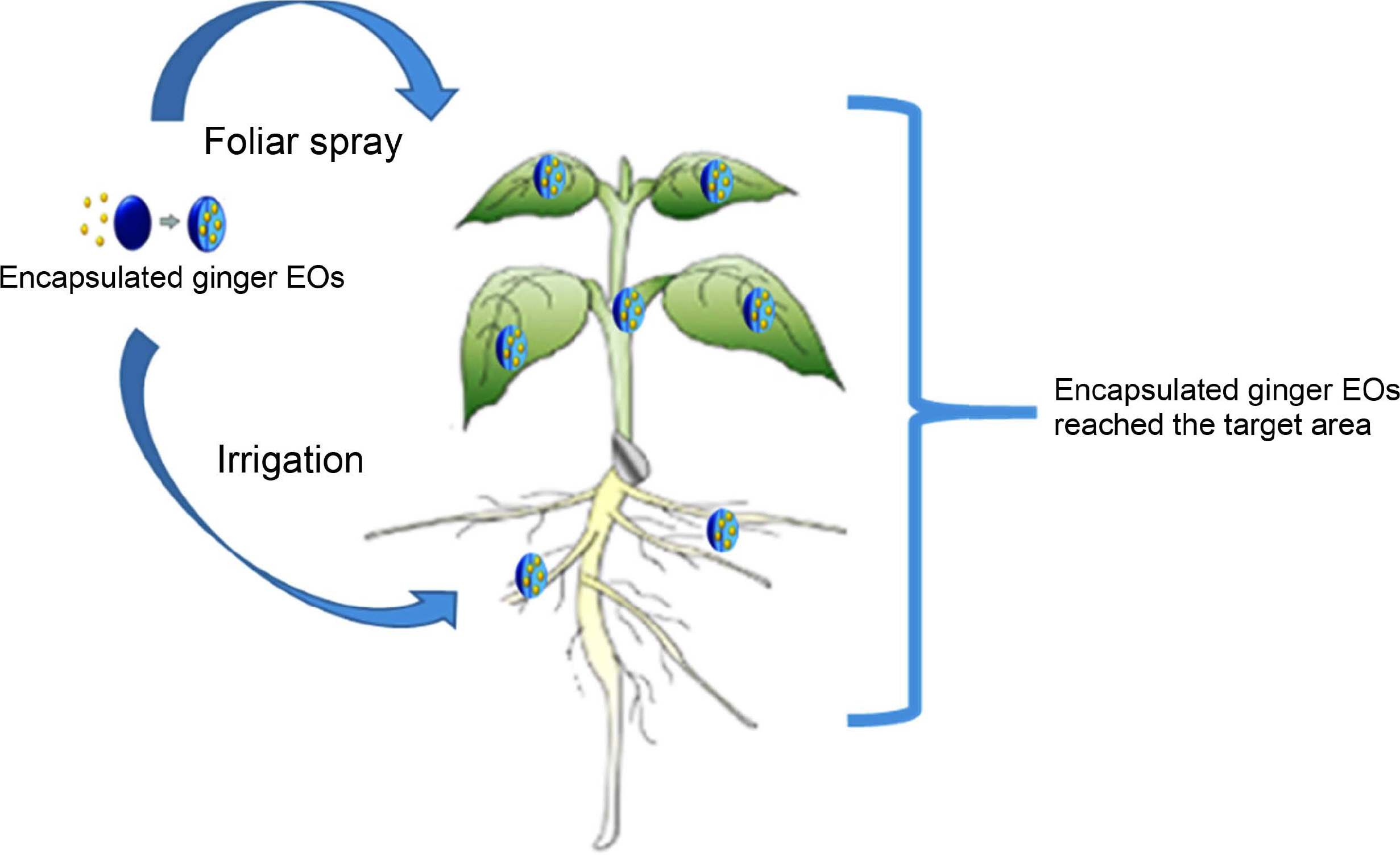
Application of encapsulated ginger essential oils (EOs) with its physical and chemical stability to the target locations. Nanoemulsion-related benefits include bioavailability, controlled release, and protection of EOs from environmental stresses. Their applications are promising agents that can be used in plant protection to improve the anti-microbial, antifungal, antiviral and pesticide activities of EOs. This may solve many agricultural problems in plant-pathogen interactions.
The emergence of EOs as one of the imperative tools for plant disease control in the tropics will also continue to be a driving force economically for changing the present agricultural practices to better. Novel delivery systems for plant protection, improvement and productivity of tropical crops have the potential to be increased with the use of nanotechnology-based EOs and hence will provide more affordable solution (Acharya and Pal, 2020). These encapsulation technologies and controlled methods of release have transformed the use of nanotechnology-based ginger EOs as an antibacterial for preservation of tropical crops (Prasad et al., 2014). It is a hybrid smart delivery systems which could only be released when needed, resulting in greater preservation of tropical crops and lower costs through the use of farm manpower (Nirmala and Nagarajan, 2017). At present, nanotechnology is one of the most promising disease control technologies for protection and preservation of tropical crops against bacterial and/or fungal pathogens. Some of the top companies in the world are focusing on formulating nanoscale pesticides for delivery via nanoencapsulation into the target host tissue. Many formulations are made to contain nanomaterials (Table 6). These materials dissolve well in water to enhance their activities. Thus, they are employed as nanoscale particles to constitute antimicrobial nanoparticle suspensions which can be conveniently combined with different media such as gels, liquids and creams (Prasad et al., 2014).
Past researches had revealed that different nanoparticles affect disease causing organisms, rodents, and insects. Therefore, it imperative to use nanoscale to prepare new formulations which are made from natural products such as EOs for pesticides, insecticides, and insect repellants (Rai and Ingle, 2012). The use of nanoparticles innovations in plant disease control can also solve many agricultural problems in plant-pathogen interactions (Ghormade et al., 2011). The research of Valentim et al. (2018) revealed that EOs-nanoemulsion is effective against Colossoma macropomum monogeneans. Likewise, nanoemulsions containing citral-EOs have the capability of disrupting and penetrating the lipid structure of the bacterial cell wall. It results in protein denaturation and cell membrane destruction followed by cytoplasmic leakage and conformational changes and cell death. Nanoemulsion composition significantly affects antimicrobial activities. A guided delivery system of functional molecules produced from EOs would function in the treatment of plant diseases (Lu et al., 2018). Mahdavi et al. (2018) revealed that polymeric nanofibers containing ginger EOs showed that because of the steady and continuous released of the effective components of EOs loaded onto nanofibers become more powerful.
Researches have demonstrated that nanotechnology are suitable carriers of active materials because they can be rapidly prepared, they have a simple structure, they have better thermodynamic stability, their cost of production low, and they can be mass produced (Echeverria and de Albuquerque, 2019). Nanotechnology-based systems have many advantages such as (1) higher ratio of surface to area and higher free energy making them efficient transport system because higher surface improves absorption rate and also reduces volatility, thus increasing bioavailability and active ingredient absorption, (2) no possible intrinsic creaming, flocculation, coalescence, and sedimentation, because they are thermodynamically and kinetically stable, (3) they reduce volatility, thus increasing absorption rate and amount, (4) their formulation can be applied as foams, creams, oils, and sprays, (5) their non-toxic, non-irritating nature of nanoemulsion provides basis for their application to protect and preserve tropical crops, (6) nanoemulsions can bring active ingredients of both hydrophilic and lipophilic parts to the desired site, (7) nanoemulsions protect the active ingredients against hydrolysis and oxidation because of oil-droplet encapsulation, and (8) development and application of nanoemulsions are economically viable compared with other delivery systems.
Future Prospects and Conclusion
Ginger EOs could be sustainable alternative for controlling tropical plant diseases. Being environmental friendly, the interest in the use of EOs in crop protection is increasing. The emergence of resistant bacteria and fungi pathogens to many antimicrobial agents is a major challenge in agriculture. Hence, new antimicrobials are needed. The use of ginger EOs in plant disease control will mitigate major agricultural problems in plant-pathogen interactions. Nevertheless, their use in agriculture has been limited by their relatively low water solubility and stability coupled with their high volatility. Nanotechnology is a groundbreaking technology with possible uses in agriculture. Furthermore, nanoparticles are attractive resources because they can solve the limitations of EOs such as light, humidity, and warm temperature. By exploiting EOs potentials and creating synergies between EOs and their constituents using state of the technologies, the problems of plant disease control in the tropics can be minimized.
The plant protection concept emphasizes production of safe crop with the least possible effect on the agro-ecosystem, discourage the use of chemical control measures, and supports the use of natural products, such as ginger EOs/ginger Eos-based nanotechnology. Scientific evidences to support the use of both preventive and direct plant protection measures using natural products that may reduce uneconomic, unjustified chemical pesticide treatments, and reduction of adverse environmental and human health impacts are overdue. Sustainable plant protection entails the potential use of ginger EOs/ginger Eos-based nanotechnology for sustainable and effective plant disease control in the tropics.
Acknowledgments
The authors thank the staffs of Department of Plant Protection, Faculty of Agriculture, Universiti Putra Malaysia for their technical assistance. Special appreciation to the Ministry of Higher Education Malaysia for proving a research funding under Long-term Research Grant Scheme (LRGS/1/2019/UPM/2).
Notes
Conflicts of Interest
No potential conflict of interest relevant to this article was reported.

